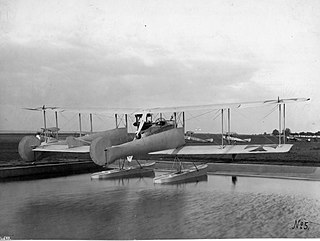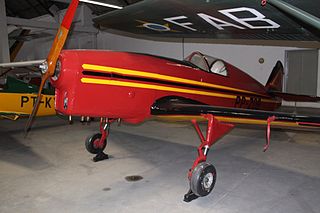Related Research Articles

The Arado Ar 231 was a lightweight floatplane, developed during World War II in Nazi Germany as a scout plane for submarines by Arado. The need to be stored inside the submarine necessitated compromises in design that made this single-seat seaplane of little practical use.

The Messerschmitt Bf 108 Taifun was a German single-engine sport and touring aircraft, developed by Bayerische Flugzeugwerke in the 1930s. The Bf 108 was of all-metal construction.

The Fieseler Fi 5 was a single-engined two-seat sportplane of the 1930s. It was produced by the German aircraft manufacturer Fieseler Flugzeugbau, which was started by the World War I fighter ace and German aerobatic star, Gerhard Fieseler.

The Göppingen Gö 9 was a German research aircraft built to investigate the practicalities of powering a plane using a pusher propeller located far from the engine and turned by a long driveshaft.

The Heinkel He 116 was an extremely long-range mail plane designed to deliver airmail between Germany and Japan. Several examples were built for this role, as well as a small batch to be used in the long-range reconnaissance role.
The Gotha Go 244 was a transport aircraft used by the Luftwaffe during World War II.

The Fieseler Fi 157 was an unsuccessful attempt at developing a radio-controlled, full-sized anti-aircraft target.

The Bücker Bü 133 Jungmeister was an advanced trainer of the Luftwaffe in the 1930s. It was a single-engine, single-seat biplane of wood and tubular steel construction and covered in fabric.
The Gotha Go 146 was a twin-engine utility aircraft developed in Germany in the mid-1930s. It was a conventional low-wing cantilever monoplane with tailwheel undercarriage, the main units of which retracted into the engine nacelles on the wings. It was offered to the Luftwaffe as a high-speed courier aircraft, but the Siebel Fh 104 was selected instead. With Gotha unable to attract other customers, no serious production was undertaken and a small number of prototypes were the only examples built.

The Klemm Kl 36 is a 1930s German four-seat cabin touring and competition monoplane. It was designed by Klemm and Friedrich Fechner and built by Klemm.

The Gotha WD.3 was a pusher reconnaissance floatplane built in prototype form in Germany in 1915.

The Gotha WD.14, WD.20, and WD.22 were a family of biplane torpedo bomber floatplanes developed in Germany during World War I.
The Janowski J1 Prząśniczka ("Distaff"), later named the Don Kichot was an ultralight aircraft designed in Poland and marketed for homebuilding in the 1970s. Designed by Jarosław Janowski in 1967 and built with the help of some friends, it flew three years later. It had an unusual design, with a high, strut-braced wing and a pusher propeller mounted behind it. The pilot had a fully enclosed cabin, and the undercarriage was of fixed, tailwheel type. Original prototype was flown with Saturn engine design by Mr Janowski. This engine was made out of two motorcycle engines (MZ250). J1 was also flown with Trabant engine (29HP) and VW conversion (48BPH) made by Christine Aero Engines in Donlands - California.

The Fieseler Fi 158 was a civilian research aircraft designed and built in Germany from 1938.

The Gotha Go 147 was a German experimental two-seat tailless aircraft designed in 1936 by Gothaer Waggonfabrik and Dr. A. Kupper. Two examples were built and flown. Development was abandoned before the start of World War II.
The Arado Ar 69 was a two-seat German beginner's school and sport biplane with an open cockpit, developed in 1933 by Arado Flugzeugwerke.

The Heinkel He 71 was a German single-seat monoplane, a smaller version of the two-seat Heinkel He 64. A low-wing monoplane with a fixed conventional landing gear, the prototype first flew with an open cockpit and a 60 hp (45 kW) Hirth HM 60 engine. It was later modified with an enclosed cabin and a 78 hp (58 kW) Hirth HM 4 engine. With additional fuel tanks to increase range it was used by German aviator Elly Beinhorn on a flight around Africa.

The Fieseler Fi 99 Jungtiger was a German sports aircraft prototype, produced by Fieseler company. The aircraft was a low-wing two-seat aircraft with an enclosed cabin. It was powered by a Hirth HM 506A engine, producing 160 hp (119 kW).

The Gotha Go 150 was a light aircraft designed at the German company Gothaer Waggonfabrik in the late 1930s. It was intended for civilian use, but ended up being used as a military trainer.

The IPT-16 Surubim was a Brazilian single-seat, single engined experimental light aircraft. A single example was built and flown in 1959.
References
- ↑ Metzmacher, Andreas (2005). "Geheimprojekt "Ultrarot"". Flugzeug Classic (in German) (11): 80–82. ISSN 1617-0725.
- 1 2 3 Nowarra, Heinz J. (1993). Die Deutsche Luftrüstung 1933–1945 Vol.2 – Flugzeugtypen Erla-Heinkel (in German). Koblenz: Bernard & Graefe Verlag. pp. 138–139, 268–269. ISBN 3-7637-5464-4.